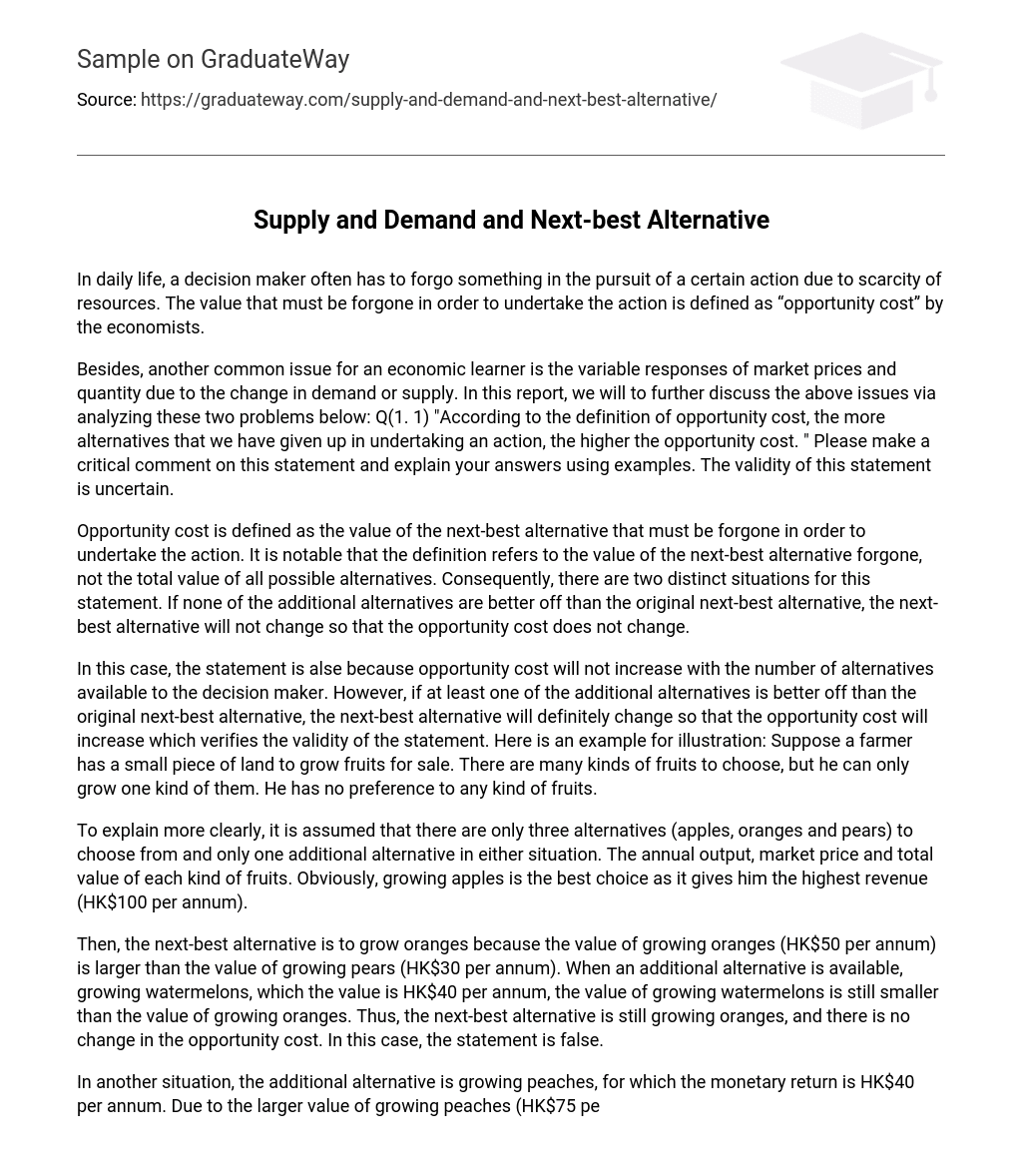When individuals make decisions in their daily lives, they often need to sacrifice something because resources are limited. Economists call this sacrifice “opportunity cost.”
Additionally, individuals studying economics often encounter a common obstacle – comprehending the relationship between market prices and quantity in response to shifts in demand or supply. This report aims to investigate this matter by examining two specific predicaments: Q(1.1) “The concept of opportunity cost suggests that the greater number of alternatives foregone when making a decision results in a higher opportunity cost.” Please provide an evaluative analysis of this statement and substantiate your viewpoint with examples. The accuracy of this assertion is uncertain.
Opportunity cost refers to the value of sacrificing the next-best alternative in order to pursue a specific action. It focuses specifically on the lost value of the next-best alternative, rather than considering all possible alternatives. This gives rise to two distinct situations: if none of the other alternatives offer greater benefits than the original next-best option, there will be no alteration in either the next-best alternative or its corresponding opportunity cost.
Despite the assertion, having more alternatives does not raise the opportunity cost for a decision maker. However, if one of the additional alternatives surpasses the original next-best alternative, then the next-best alternative will be altered and lead to an augmented opportunity cost. To demonstrate this scenario, let’s consider a farmer who owns a small plot of land dedicated to fruit cultivation for sale. There are numerous fruit options available to choose from, but he can only pick one variety. The farmer doesn’t have any particular preference for a specific fruit.
To provide a more thorough explanation, we will explore three options: apples, oranges, and pears. Each option has only one alternative. We must evaluate the annual production, market price, and overall value of each fruit category. It is clear that growing apples is the most profitable choice as it yields an annual revenue of HK$100.
Therefore, if the cultivation value of oranges is HK$50 per year, it surpasses that of pears (HK$30 per year), making growing oranges the next-best option. Even though watermelons have a cultivation value of HK$40 per year as an additional choice, it still falls short compared to growing oranges. Consequently, cultivating oranges remains the preferable alternative without any change in opportunity cost. Thus, the statement in this scenario is inaccurate.
The monetary return for growing peaches is HK$40 per year, which is higher than the HK$50 per year for growing oranges. Therefore, the alternative to growing oranges will change to growing peaches, resulting in an increased opportunity cost. This statement holds true in this scenario.
To summarize, the statement’s validity is determined by the values of the additional alternatives. If one of these alternatives has a higher value than the original next-best alternative, it is considered valid; otherwise, it is considered invalid. Q(2.1) By analyzing the stock price and volume information obtained from the newspaper, we can assess if there were changes in demand or supply for each stock between 3 August 2011 and 4 August 2011. This assumes that either the demand curve or the supply curve changed, but not both.
The closing price of each stock indicates the market equilibrium price, while the volume transacted reflects the market equilibrium quantity. Therefore, prioritizing the highest or lowest price is not necessary. For HSBC’s stock, Table 3 and Table 4 show a decrease in its closing price from $77.00 to $76.15, accompanied by a decline in the volume transacted from 29,743 (1,000s) to 19,381 (1,000s). This decrease can be attributed to a leftward shift in the demand curve for this particular stock.
Despite a decrease in demand for HSBC’s stock, there was an increase in closing price for MTRC’s stock from $26.00 to $26.10. However, the volume transacted decreased from 4,398 (1,000s) to 2,424 (1,000s). Figure 2 demonstrates that the supply curve for MTRC’s stock shifted leftward, indicating a decrease in supply.
In contrast, Cathay Pacific’s stock experienced a decrease in closing price from $17.82 to $17.60 despite an increase in volume transacted from 9,030 (1,000s) to 11,533 (1,000s). Figure 3 shows that the supply curve for Cathay Pacific’s stock shifted rightward.
The suggestion proposes boosting the availability of Cathay Pacific’s stock. If HSBC had closed at $77.00 on August 4, 2011, rather than $76.15, while keeping all other information unchanged, the conclusion regarding changes in demand and supply curves between August 3 and 4, 2011 would be as follows: The equilibrium price remained constant, but the equilibrium quantity decreased from 29,743 (1,000s) to 19,381 (1,000s). It is evident that both the demand and supply for this stock reduced by an equivalent amount.
Despite a decrease in demand leading to a lower equilibrium price and smaller equilibrium quantity, the decline in price is counterbalanced by an increase in equilibrium price caused by a decrease in supply. In this situation, both the supply curve and demand curve must shift left to the same degree.
If on 4 August 2011, MTRC’s volume was 4,398 instead of 2,424 (with all other information remaining constant), it can be deduced that between 3 and 4 August 2011, both the demand and supply curves shifted. The equilibrium quantity remained unchanged while the equilibrium price increased.
Both the increase in demand and decrease in supply for this stock appear to be roughly equal. Despite the increase in demand, which causes the equilibrium price and quantity to rise, it is offset by the decrease in supply, resulting in a lower equilibrium quantity. As a result, the supply curve shifts to the left while the demand curve shifts to the right. The extent of the leftward shift in the supply curve is nearly identical to that of the rightward shift in the demand curve, thus keeping the equilibrium quantity unchanged.





